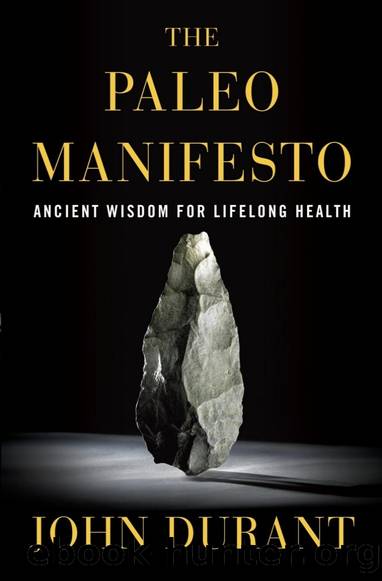The Paleo Manifesto: Ancient Wisdom For Lifelong Health by John Durant

Author:John Durant [Durant, John]
Language: eng
Format: epub
ISBN: 9780307889195
Amazon: B0083DJU7A
Barnesnoble: B0083DJU7A
Goodreads: 13642129
Publisher: Crown Publishing Group
Published: 2013-09-17T05:00:00+00:00
BEYOND MOTIVATION, where is fitness headed? What is the future of the gym?
A hint lies in a seemingly unlikely place: the playground.
There has always been a certain wildness to children at play. Kids donât run at a steady pace on a treadmill; they sprint, pivot, and dodge during a game of tag. They are born with an instinct to run, wrestle, roughhouse, climb, crawl, and jump. Kids have to be taught how to play sports; they donât have to be taught how to play.
Humans are not the only species in which the juveniles play. Lion cubs pounce and wrestle, and baby antelope run away from each other and kick. Playtime isnât a frivolous pursuit at all but actually has an important biological function. Itâs an adaptive behavior to prepare juveniles for the challenges of adulthood. Play is a way to practice essential survival skills.
Different species face different survival challenges and, unsurprisingly, there are different types of play. Predatory play (such as pouncing, nipping, or pawing) is found among predator species like felines, canines, and otters. Locomotor play (such as running, leaping, or kicking) is observed in prey species like horses, zebras, and goats. Object play (such as grasping, holding, or throwing) is seen in humans, as well as chimpanzees. Social play (make-believe, mock aggression, or playing at being adults) is also seen in human beings, who have complex social lives and depend heavily on learning local culture.
Play is skill development, and skill development requires neurological wiringânot simply raw aerobic capacity or muscle strength. That takes time, practice, and focus.
Hunting an antelope isnât easy. Though cheetah cubs will grow up to become the fastest animals on land, they still need to practice for years before they become successful hunters. Biologist Dr. Tim Caro documented how cheetah cubs practice on actual prey. Initially, the mother cheetah will bring back dead hares and gazelles, and the cheetah cubs will pounce on them. Over time, the mother will bring back wounded animals, which the cubs will chase and attempt to kill. When the prey (almost inevitably) gets away, the mother will go catch it and bring it back again. This may continue a few times before the mother finally kills the prey. Occasionally the prey escapes entirely, which underscores the importance of practiceâthe benefits of play are worth the risk of losing dinner.
Zoos have learned the hard way that skill development is essential to successfully reintroducing animals into the wild. The wild population of golden lion tamarins, a beautiful monkey native to Brazil, had declined to just a few hundred individuals. In the 1980s, conservation efforts at the National Zoo in Washington, D.C., led to a re-introduction program: captive-born tamarins would be raised at the zoo, trained for the wild, and then flown to Brazil and released.
At the National Zoo the tamarins were split into two groups. A free-ranging group was given access to zoo grounds. With that came exposure to natural surfaces, aerial predators, and weather conditions. A captive group remained in their
Download
This site does not store any files on its server. We only index and link to content provided by other sites. Please contact the content providers to delete copyright contents if any and email us, we'll remove relevant links or contents immediately.
The Body: A Guide for Occupants by Bill Bryson(5027)
Audition by Ryu Murakami(4887)
Adulting by Kelly Williams Brown(4529)
Housekeeping by Marilynne Robinson(4391)
1578 Plant Pattern Recognition Receptors by Unknown(4326)
Be in a Treehouse by Pete Nelson(3996)
Zero Waste Home by Bea Johnson(3804)
Seriously... I'm Kidding by Ellen DeGeneres(3605)
Better Homes and Gardens New Cookbook by Better Homes & Gardens(3547)
The Healing Self by Deepak Chopra(3522)
Barkskins by Annie Proulx(3334)
Hedgerow by John Wright(3313)
The Cellar by Natasha Preston(3296)
Spark Joy by Marie Kondo(3269)
The Genius of Japanese Carpentry by Azby Brown(3254)
The Life-Changing Magic Of Tidying Up- The Japanese Art Of Decluttering And Organizing (v5.0) by Marie Kondo(3233)
120 Days of Sodom by Marquis de Sade(3223)
Work Clean by Dan Charnas(3078)
The Book of Numbers by Peter Bentley(2928)
